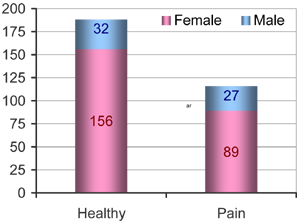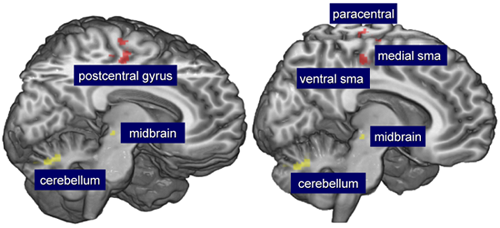| Issue 1.1 — Spring 2014 | |
 |
In This Issue
|
| A Message from Emeran A. Mayer – Chair, Executive Committee | |||||||||||||||||||||||
|
Welcome to the first issue of the PAIN Repository Newsletter. We are excited to announce that the NIH funded PAIN Repository is now fully functional and ready to accept scans from PAIN Members that have registered. Both the Archived (older and/or non standardized scans) and the Standardized Repository (for prospective, standardized scans) are fully operational. Our group has already uploaded 254 scans into the Archived, and 20 scans into the Standardized Repository. Several members are in the process of doing the same. We hope that many of the already committed members will soon follow this example. In the following FAQ, I wanted to address several important questions that have come up from participating members, in particular as it relates to the Standardized Repository. I hope you will find the answers below helpful and that they will help to allay any concerns regarding uploading of scans from data sets that you have not yet published. Over the next few weeks we will contact all of you individually to encourage you to use the standardized acquisition parameters and start uploading your scans. For any prospective new members I hope this information will also be useful and I encourage you to explore our website at painrepository.org for detailed information on the PAIN repository and how you can become involved. |
|||||||||||||||||||||||
| PAIN Repository FAQ | |||||||||||||||||||||||
| Q | Why should I contribute my (unpublished) scans to the Standardized Repository? | ||||||||||||||||||||||
| A |  We fully understand the reluctance share data that is either newly collected or has not been completely analyzed and the concern that this may compromise your own future use of the data. On the other hand, the only way to rapidly build a large enough database of standardized images for members to use to examine questions not addressable in smaller individual data sets is if members start participating in the Standardized Repository ASAP. We therefore encourage you to: We fully understand the reluctance share data that is either newly collected or has not been completely analyzed and the concern that this may compromise your own future use of the data. On the other hand, the only way to rapidly build a large enough database of standardized images for members to use to examine questions not addressable in smaller individual data sets is if members start participating in the Standardized Repository ASAP. We therefore encourage you to: |
||||||||||||||||||||||
|
|||||||||||||||||||||||
| Recent Media Coverage | |

The Collective Good: Pooling Data to Boost Brain Imaging Research Two new resources enable collaboration reported on February 6, 2014 Database of Brain Images for Chronic Pain Voice of America reported Nov. 6 that the Gail and Gerald Oppenheimer Family Center for Neurobiology of Stress will serve as the main hub for a first-ever international database of brain images and other clinical information associated with chronic pain conditions. Dr. Emeran Mayer, professor of medicine in the division of digestive diseases, physiology and psychiatry and executive director of the Gail and Gerald Oppenheimer Family Center for Neurobiology of Stress and Dr. Kirsten Tillisch, associate professor of medicine in the division of digestive diseases at the David Geffen School of Medicine at UCLA, were interviewed.
UCLA Database to House Brain Scans, Other Data for Chronic Pain Research UCLA database to house brain scans, other data for chronic pain research reported on Oct. 30, 2013 on American Pain Society Smart Brief |
|
| Current Data | |
|
Our growing body of data contains structural and functional brain scans from patients with chronic pain conditions and healthy controls contributed by members and available for analysis.In addition, the PAIN Standardized Repository also offers clinical, psychosocial and behavioral data. The Executive Committee evaluates all requests for data, and encourages collaborations among multiple researchers and institutions. |
|
|
Standardized Repository Number of Structural Scans: 20 |
 |
|
Archived Repository Number of Structural Scans: 304 |
 |
| Recent Publications | |
We would like to highlight a recent brain imaging study which demonstrates the feasibility and power of multisite neuroimaging study approaches. In the first study of its kind, CNS researcher Lisa Kilpatrick, PhD along with a team of scientists from UCLA and other prominent universities, report specific changes in activity in the resting brain of women with chronic urological pelvic pain. |
|
 |
Sensory motor regions shown in red displayed altered activity and altered connectivity with the regions in yellow. |
|
The US wide study compared 82 carefully screened patients with 85 matched healthy controls was performed as part of the National Institutes of Health Multidisciplinary Approach to the Study of Chronic Pelvic Pain (MAPP) Research Network for which the CNS is the lead Neuroimaging site. Scans from 6 sites acquired on 4 scanner models using a standardized acquisition protocol were combined for analysis. Findings from the study clearly show altered intrinsic brain activity in the patient group in areas involved in sensation and control of pelvic muscles. Abnormal pelvic floor muscle activity is thought to play a key role in generating pelvic pain symptoms and the newly reported findings point to brain changes that may be involved in the maintenance and/or exacerbations of these symptoms. Other findings from the study indicated that alterations in the brain may separate patients with primarily chronic pain from those with bladder specific symptoms (such as increased pain with filling) and follow up research may therefore help individualize treatment for specific types of pelvic pain. This is the first of several multisite brain image analyses and publications from this consortium, evaluating group differences for grey matter, white matter and resting state data, analyzing subsets based on symptoms, sex and disease category. It demonstrates the power of being able to analyze large, standardized datasets with the ultimate goal of identify fingerprints of chronic pain disorders. For more info see http://www.ncbi.nlm.nih.gov/pubmed/24681331 |
|
| The Oppenheimer Center for Neurobiology of Stress at UCLA CHS 42-210 MC737818 10833 Le Conte Avenue Los Angeles, CA 90095-7378 Phone: (310) 206-0192 info@painrepository.org |
|